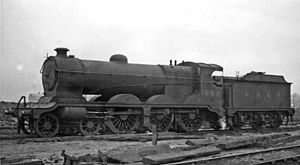This article relies largely or entirely on a single source .(January 2015) |
| Great Central Railway Class 8 | |||||||||||||||||||||||||||||||||||||||
|---|---|---|---|---|---|---|---|---|---|---|---|---|---|---|---|---|---|---|---|---|---|---|---|---|---|---|---|---|---|---|---|---|---|---|---|---|---|---|---|
 Ex-Great Central 'Fish' class 4-6-0 at Mexborough Locomotive Depot | |||||||||||||||||||||||||||||||||||||||
| |||||||||||||||||||||||||||||||||||||||
| |||||||||||||||||||||||||||||||||||||||
| |||||||||||||||||||||||||||||||||||||||
| |||||||||||||||||||||||||||||||||||||||
The Great Central Railway Class 8, known as the London and North Eastern Railway Class B5 following the 1923 Grouping, was a class of fourteen 4-6-0 steam locomotives designed to haul fast goods trains, in particular fish trains.
Contents
They were nicknamed "Fish Engines" because of their designed role and due to their frequent use on the fast fish trains heading from Grimsby to places like London. They were passed on into service with British Railways in 1948 and the last locomotive was withdrawn in 1950.